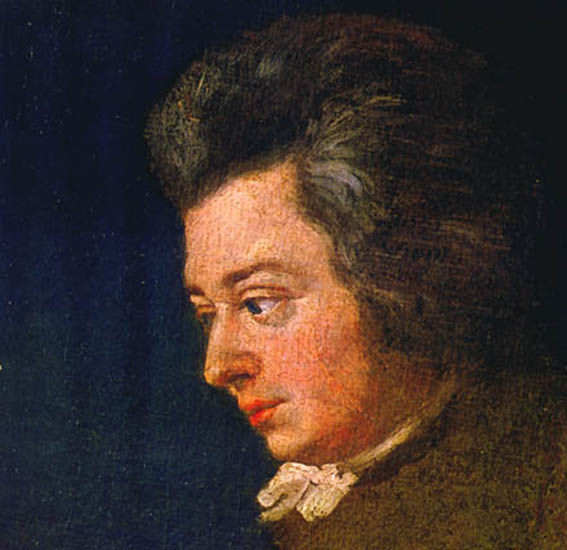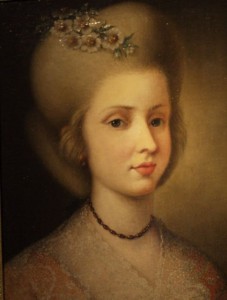Wolfgang Mozart (1756-1791)
Born January 27, 1756 in Salzburg, Austria.
Died December 5, 1791 in Vienna, Austria.

Concert Arias, K. 416 and 419
Composed 1782.
Having left his position that lacked opportunity for advancement at the Salzburg court of Archbishop Hieronymus Count von Colloredo, Mozart needed a new source of income. With Paris intended as a final destination, Mozart and his mother depart Salzburg on September 23, 1777 to embark on a journey to find gainful employment. They planned a stay in Mannheim, which is not only the midpoint of the journey but was the home of the famed court orchestra (where the crescendo was invented). They arrived in Mannheim on October 30 and remained there for several months while Mozart tried to secure a position at the Mannheim court. Many of the Mannheim musicians held him in high esteem, remembering his astonishing talent from his previous visits. His social engineering efforts were in vain, for even with the endorsement of several Mannheim musicians (e.g. Stamitz’ successor Cannabich), he was not engaged. During this Mannheim stay he was in need of a copyist. His friends recommended Fridolin Weber, copyist, violinist, bass singer and theater prompter at the Mannheim court. It was this Weber who was also Carl Maria von Weber’s uncle. In January 1778 Mozart took a month long trip to nearby Kirchheimbolanden with Fridolin Weber and his 17 year old daughter Aloysia (1760? – 1839).

During this trip Mozart became enamored with Aloysia who, in addition to her physical beauty, was a gifted pianist and soprano. Aloysia was probably Mozart’s first love. After returning to Mannheim, he composed his first of many arias for Aloysia on February 24, Alcandro, lo confesso, K 294. Mozart and his mother left Mannheim on March 14 and arrived in Paris on March 23. In June he composed his second aria for Aloysia, Popoli di Tessaglia K. 316/300b. His mother died in Paris on July 3 but Mozart remained there until September. On November 6 he arrives in Mannheim but Aloysia was no longer there. After the death of Maximilian III Joseph,the Elector of Bavaria, his successor Karl Theodor left Mannheim for Munich. With this move to Munich, all of the Mannheim musicians including the Webers were uncertain of their future. In July 1778, Aloysia sang in a concert where the director of the Munich National Theater heard her. The Weber family then relocated to Munich. On December 25, Mozart arrived at the Weber’s new home in Munich intending to present Aloysia with Popoli di Tessaglia. According to Mozart’s first biographer, Georg Nikolaus von Nissen (who married Constanze in 1809), Mozart had an unexpected welcome: “When he entered, she appeared no longer to know him, for whom she previously had wept. Accordingly, he sat down at the piano and sang in a loud voice, ‘Leck mir das Mensch im Arsch, das mich nicht will'” [Nissen p. 414, Quoted from Solomon 1995, p. 169.] Mozart was fond of variations of this phrase and set it several times, most notably the B flat canon K. 231. On December 29, 1778 he described his pain in a letter to his father writing “Today I can do nothing but weep.” This rejection doesn’t appear to have any long-term estrangement from the Weber family. After Mozart moved to Vienna in 1781, he lodged with the Webers who had moved there in 1779 after Aloysia was hired by the German National Theater. Fridolin died suddenly barely a month after the move, so by necessity they had to take in boarders. On October 31, 1780, Aloysia had married Joseph Lange who painted the famous unfinished portrait of Mozart. With Aloysia’s rejection now complete, Mozart fell in love with Constanze whom he later married. Mozart continued to write music for Aloysia. The two arias on today’s concert were written for her.
Mia speranza adorata…Ah, non sai qual pena.
soprano and orchestra, K.416
Duration: approximately 9:30
Author: Gaetano Sertor
Completed Jan 8, 1783 in Vienna.
First Performance: January 11 1783 at the Mehlgrube in Vienna.
Instrumentation: Soprano, 2 oboes, 2 bassoons, 2 horns, strings.
Today we may think it to be a bizarre practice but in Mozart’s time it was common to insert arias written by one composer into another composer’s opera. Mozart wrote several of these “insertion (or substitution) arias” for Neapolitan composer Pasquale Anfossi (1727 –1797). The text is from Anfossi’s opera Zemira that premiered in Venice in 1781. Aloysia performed this scene – a recitative and aria – in her own concert at the Mehlgrube, a concert room near the flour market and site of premieres of many of Mozart’s piano concertos, on January 11 – only 3 days after Mozart completed it! She sang it again at Mozart’s academy on March 23 at the Burgtheater (The “Haffner” Symphony was also on the program).
The recitative and aria is about Gandarte and his wife Zemira have been captured by the Mongol Emperor Akbar. The emperor has chosen Zemira to be his, well, “companion.” Gandarte is lamenting this loss and bids farewell to Zemira.
The halting recitative is lightly scored for only the strings with a languid solo oboe floating above. The aria is a rondo – the music for the phrase “Ah non sai qual pena” keeps returning. The aria combines lyricism with coloratura runs that repeatedly reach to high F setting the words “il doverti .. lasciar” (to have to leave you).
| Italian | English |
|---|---|
| Mia speranza adorata! | My adored hope! |
| Ah! troppo è a noi l’ira del ciel funesta; | Ah! the wrath of heaven is too dire to us! |
| L’ultima volta è questa, | This is the last time |
| Ch’io ti stringo al mio seno. | that I shall hold you to my breast! |
| Anima mia, Io più non ti vedrò. | My soul, I shall see you no more. |
| Deh, tu l’assisti, tu per me la consola. | You there, help her, console her for me. |
| Addio, Zemira, Ricordati di me! | Farewell, Zemira, remember me! |
| Senti . . . che vedo? . . . | Hear me… what’s this? . . . |
| Tu piangi, o mio tesoro! | You are weeping, my darling! |
| Oh, quanto accresce quel pianto il mio martir! | Oh, how those tears increase my suffering! |
| Chi prova mai Stato peggior del mio | Who ever found himself in worse straits than I? |
| Addio per sempre, amata sposa, addio! | Farewell for ever, for ever, dear wife, farewell! |
| Ah non sai qual pena sia Il doverti, | Ah! You do not know what anguish it is |
| oh Dio! lasciar! | oh, God! To have to leave you! |
| Ma quel pianto, anima mia | But those tears, my dearest, |
| Fa più grave il mio penar. | make my suffering harder. |
| Deh, mi lascia, oh fier momento! | If only the terrible moment would pass! |
| Cara sposa, ah, ch’io mi sento | Dear wife! Ah, but I feel |
| Per l’affanno il cor mancar! | my heart fail me with grief. |
| A quai barbare vicende | What a barbarous torment |
| Mi serbaste, avversi Dei, | you have prepared me for, hostile gods! |
| Dite voi, se i casi miei | Tell me, if my circumstances |
| Non son degni di pietà. | are unworthy of pity. |
No, no, che non sei capace
soprano and orchestra, K. 419
Duration: approximately 5:00
Author: Unknown.
Completed June, 1783 in Vienna.
First Performance: June 1783 at the Burgtheater in Vienna.
Instrumentation: Soprano, 2 oboes, 2 horns, 2 trumpets, timpani and strings.
Mozart wrote this for Aloysia as an insertion aria for her Vienna debut with the Italian Opera Company in Pasquale Anfossi’s opera Il curioso indiscreto (The indiscreet snoop). This aria is in two parts – an Allegro (“quickly”) scored for strings with brief interjections from the winds and an Allegro assai (allegro, and I mean it this time) when she sings the words “Go! I abhor you” which is answered by tutti strings reinforced by forceful winds.
In a story similar to Così fan Tutte, the Marquess Calandrano decides to test the fidelity of his fiancée Clorinda by sending his friend, the Count of Ripaverde, to try to seduce her. Although Clorinda rebuffs the Count, his wounded male ego would not allow him to admit his failure to the Marquess. When Clorinda hears this canard she angrily protests her innocence with this fiery “rage aria.” The virtuosic runs into the stratosphere where the high tessitura (where the notes are written regarding the range of the voice or instrument) remains for long stretches recalling another famous rage aria sung by the Queen of the Night in the Magic Flute.
| Italian | English |
|---|---|
| No, no, che non sei capace | No, no you are incapable |
| Di cortesia, d’onore, | of courtesy, of honor, |
| E vanti a torto un coro, | and are wrong in boasting that your heart |
| Ch’arde d’amor per me. | burns with love for me. |
| Vanne! t’aborro, ingrato, | Go! I abhor you, ingrate, |
| È più me stessa aborro, | and abhor myself |
| Che t’ho un istante amato | even more that for an instant I loved you, |
| Che sospirai per te. | that I had sighed for you. |
Music written for Aloysia
From the Mannheim visit:
Recitative and Aria for Soprano, “Alcandro, lo confesso”, K. 294.
Recitative and Aria for Soprano, “Popoli di Tessaglia”, K. 316/300b.
From the Vienna years:
Scena and rondo “Mia speranza adorata … Ah, non sai, qual pena”, K. 416,
“Vorrei spiegarvi, oh Dio!” K. 418 and “No, no, che non sei capace” K. 419. “insertion arias” inserted into a revival production (June 1783) at the Burgtheater of Pasquale Anfossi’s opera “Il curioso indiscreto”.
Aria for Soprano, “Ah se in ciel”, K. 538 (1788).
Roles sung by Aloysia in Mozart’s operas
Donna Anna, in Mozart’s “Don Giovanni” at the Vienna premiere of the work, May 7, 1788.
Constanze, in a revival production of “The Abduction from the Seraglio” (1785–1788).
Resources
Public domain score of K. 416 at IMSLP
Neue Mozart-Ausgabe score of K. 416
Public domain score of K. 419 at IMSLP
Neue Mozart-Ausgabe score of K. 419
[amazon template=iframe image&asin=B0000042GL][amazon template=iframe image&asin=B000A2H7W2]
Non sei capace
One Reply to “Mozart : Concert Arias K. 416 and K. 419”